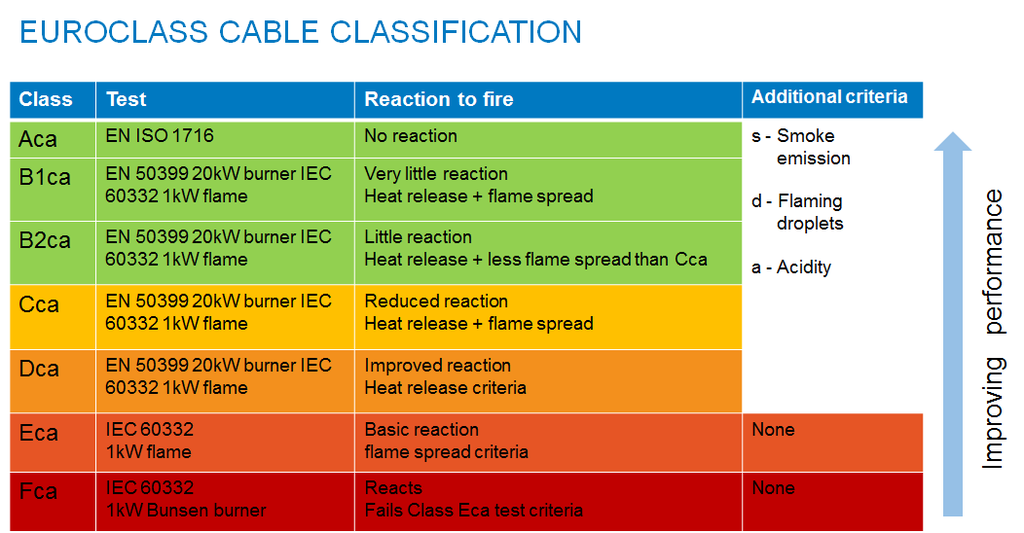
Brian Sims
Editor

Brian Sims
Editor
Cables for security systems should not act as a fuel in the event of a sure, so it is time to ensure they meets CPR compliance, says Andrew Flint.
THE EUROPEAN Commission's (EC) Construction Products Regulation (CPR) regarding fixed installation cable products, which came into effect in June 2016 and provided a 12-month grace period that ended July 1, 2017, means that all products specific to CPR now need a EuroClass rating, CE marking, and a Declaration of Performance (DoP). The bottom line is that building products intended for permanent installation, inclusive of cabling, can only be used in European buildings if they've been tested and certified in accordance with the CPR rules.
The criteria set specifically for cabling relates to performance and safety in the event of fire. The EuroClass program issues rankings based on the following:
CPR rules require power, control and communication cables installed in fixed installations in buildings to be tested and certified based on these criteria. Testing can ascertain a cable's reaction to fire and describes its behaviour during combustion along with its potential to further fuel the fire. It can also show a cable's resistance to fire and ability to continue normal operation in the event of fire.
This rigorous testing ensures that distributors, system integrators, installers, building owners/end users and consultants have trusted product information from manufacturers in different countries so they can make accurate product comparisons. This will facilitate the free movement of all construction products across the European Union (EU). Many countries have their own national fire regulations and, prior to the CPR, national fire laws containing product requirements were not harmonised. Setting the new criteria holds products to the same standards, enabling compatibility between varying manufacturers and uniformity of their actual fire performance.
UK Regulations
British Standards BS 7671 - requirements for electrical installations - requires 60332-3 cable for escape routes, which are defined as "paths to follow for access to a safe area in the event of an emergency". Based on this, and the typical 15-year design life of structured cabling systems, BS 6701 has concluded that 60332-3 cables should be installed everywhere as evacuation routes could change through the life of the building.
BS 6701 defines Installation Cables as cables intended for installation into pathways that are hidden (such as under floors, above ceilings, and behind walls) or to which access is limited and which can either be terminated in-situ or "pre-terminated". Installation cables should be used for new installations and the refurbishing or extension of existing installations. Installation cables installed in the spaces bounded by the external fire barriers of buildings and other structures shall meet, at minimum, the requirement of EuroClass Cca-slb, d2, a2. All other telecommunications cables shall meet, as a minimum, either EuroClass Eca in accordance with BS EN 13501-6 or the recommended requirements of BS EN 60332-1-2.
While the industry has moved ahead with this EU directive and is testing, grading and labelling products, the legal and regulatory frameworks still remain somewhat unclear and uneven across the EU. Specifically, neither BS7671 or BS6701 are legally required or enforceable, but the Electricity at Work Act is. Consequently, we find ourselves in a legal environment clouded in a bit of ambiguity where CPR laws and regulations are in flux. This is coupled with the fact that the CPR does allow for existing cable stock already on the market to be sold after the grace period.
To ensure customers come into compliance, Anixter, as a trusted distribution partner, strongly recommends that installers of cabling adhere to the latest building control best practices when making their sourcing and purchasing decisions. Anixter provides a broad selection of products and solutions that cater to a wide range of customer requirements, and urge customers to make purchase decisions that conform to the latest guidelines from local building control organisations. To help make the transition to CPR compliance easier, Anixter educates on the newly-emerging guidelines and requirements and recommends those products that best serve the specific needs of an installation and are compliant with the new regulation.
Cable classifications
EuroClasses are uniform assessment methods, or classifications, that mirror actual environments for building products based on reaction-to-fire performance. Euro classification is a common reference framework as the method of benchmarking the flammability of cables. There are seven EuroClasses, with additional criteria for smoke, acidity and flaming droplets. Aca, B1ca, B2ca, Cca, Dca, Eca, and Fca. Class A is the most resistant to flame, Class F is the least.
Responses to frequently asked questions on the European Commission's website explain the varying responsibilities of CPR compliance amongst manufacturers, distributors, installers and end users. The key takeaway responsibilities are:
Manufacturers
Make a declaration of Conformity/Performance stating the EuroClass grading of the particular product; Label with the CE marking; Keep documentation for 10 years; and, contingent on the product's EuroClass ranking, they may need to monitor the product per any new requirements of AVCP rules. Manufacturers also need to ensure a product is identifiable, and that its packaging provides contact and safety information in all the appropriate languages.
Distributors
Ensure that a product is compliant and have documentation to prove it; Instructions and safety information needs to be in the correct language of the market it's being sold in; Confirm that the manufacturer has identified the product and included visible contact information; If storing or moving products, the methods used cannot compromise its compliance.
Integrators and end users
Reference the harmonised technical specifications and requirements of individual characteristics when drafting the project specifications; Check the manufacturer's Declaration of Conformity/Performance, as well as national annexes or standard recommendations for assistance with appropriate minimum product performance levels; and, be vigilant about complying with local building regulations.
For detailed information on the CPR and its rules for marketing construction products in the EU, please visit the EU website at: www.ec.europa.eu
Andrew Flint is the technical services director EMEA at Anixter Ltd




Easthampstead Road
Bracknell
RG12 1YQ
UNITED KINGDOM
0044 1344 388100